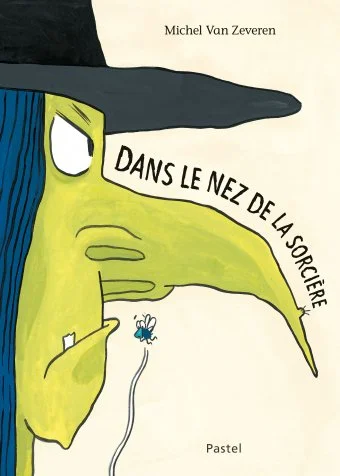“Dans le nez de la sorcière” — A Bewitching Blend of Snot and Spells
There are children’s books that enchant us, pulling us into whimsical worlds that dance between fantasy and reality. “Dans le nez de la sorcière” (literally, In the Witch’s Nose) written and illustrated by Michel Van Zeveren seemed to promise just that—a playful romp through the oddest corners of a witch’s nose, brimming with buggers, dirty flies, and all manner of delightful grotesquerie. When we stumbled upon it, my son and I were irresistibly drawn to its cover—a riot of colors and fantastical illustrations that promised a perfect Halloween treat. But as with all things in life, sometimes the journey is more bewitching than the destination itself.
A Visual Feast for Little Eyes
The illustrations alone are worth lingering over: the witch’s wild hair unfurls like a stormy sea, her nose teems with strange creatures that dance and squirm with every turn of the page. There’s a childlike wonder to the art that draws both parents and children alike into a world that feels both grotesque and magical. The colors swirl like autumn leaves caught in a mischievous wind, each page a palette that captures the eyes and imagination.
My son was entranced. And who could blame him? The mere idea of a story centered on nose buggers and sneaky flies was enough to elicit giggles and wide-eyed anticipation. For any parent familiar with a child’s fascination with all things slightly gross, this book is sure to be an instant favorite on that front alone.
A Story That Bewitches… and Bewilders
Yet, beyond the enchanting visuals, the story itself left us in a bit of a haze. The plot meanders in confusing directions: at one point, the witch abruptly transforms back into the little girl she once was (at least, that’s what it seemed?), leaving us with more questions than answers. How did she even become a witch in the first place? And now that she’s a child again, what’s supposed to happen next? Instead of following a clear path, the story jumps around unexpectedly, leaving us feeling as though we’d missed crucial details. My children, typically quick to catch on to even the most whimsical tales, found themselves puzzled, pausing with furrowed brows to ask, “Why did that happen?” and “What’s going on now?”—questions that, honestly, left even me at a bit of a loss.
There is a certain charm in children’s stories that embrace the absurd. Sometimes, it is precisely in these odd, directionless narratives that children find joy. Yet, in this case, the enchantment didn’t quite cast its spell beyond the initial allure of its art. The transformation of the witch, which seems to be the crux of the story, lacks the satisfying “aha!” moment that even the wildest of tales often gift their readers.
The Art of Embracing the Absurd?
Perhaps this story is meant to be a whimsical lesson in the nature of being loved?—an attempt at embracing a narrative that defies logic simply for the joy of reveling in its playful absurdity. Maybe it’s intended as a surreal journey into the wild imagination of a child, where the usual rules of storytelling fade away, and what truly matters is the laughter shared over yet another reading of “ew, buggers!” Perhaps it’s less about making sense and more about the giggles it elicits, leaving the storyline to fade into the background while the joy of exploring its silliness takes center stage.
But as we closed the book one last time, the lingering feeling was one of unfinished business, like a spell that never quite concluded. My children still reach for it every so often, perhaps not for the story it tells, but for the world it creates—a world filled with mischief, vibrant colors, and a witch whose nose is far more interesting than her transformation.
A Hidden Gem (For Those Who Can Read It)
One bittersweet discovery we made in our post-reading search is that “Dans le nez de la sorcière” is a hidden treasure exclusive to the French market. For families who don’t read French, it may be a bit out of reach. Yet, perhaps this can be seen as an invitation to explore the rich landscape of French children’s literature—a chance to introduce your children to the melody of a new language while embracing the absurdity of stories that don’t always fit neatly into a box.
For those who do have access to French books, this is a curious find to add to your shelves—if only for the sheer delight of seeing your little ones giggle at a witch with buggers. It may not make much sense, but perhaps that’s where its quirky charm lies. That said, it’s worth adding only if you still have plenty of space; if your bookshelf is already teetering under the weight of beloved classics, there are far better stories that deserve that precious remaining spot.
Final Thoughts: A Book to Bewitch or Bewilder?
So, would we recommend it? It’s a hesitant “yes,” with the caveat that it may leave both parents and children scratching their heads. But perhaps that’s the magic of children’s books—they don’t always need to make perfect sense. Sometimes, the joy lies in simply sharing a laugh over a witch with a nose full of surprises, even if we never quite figure out what it all means.

